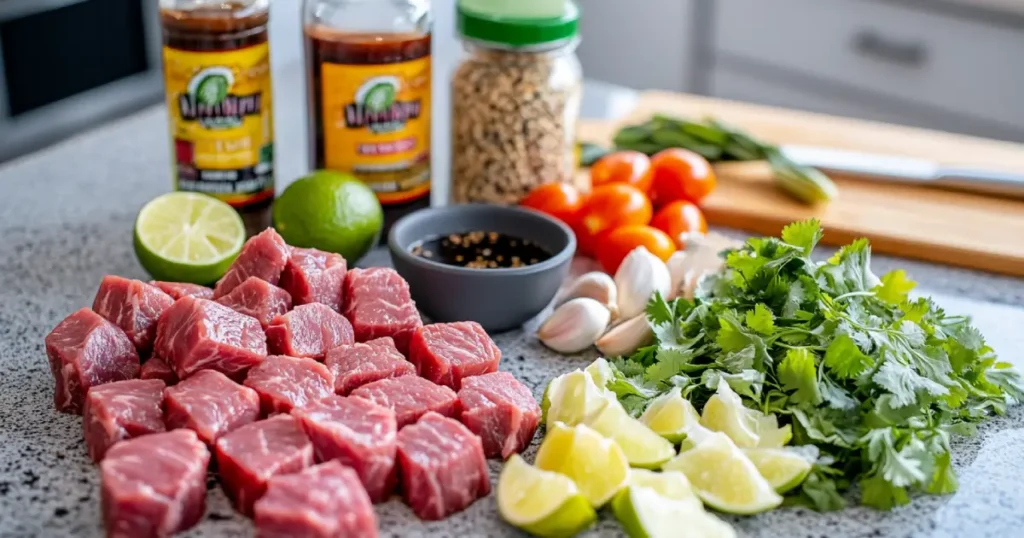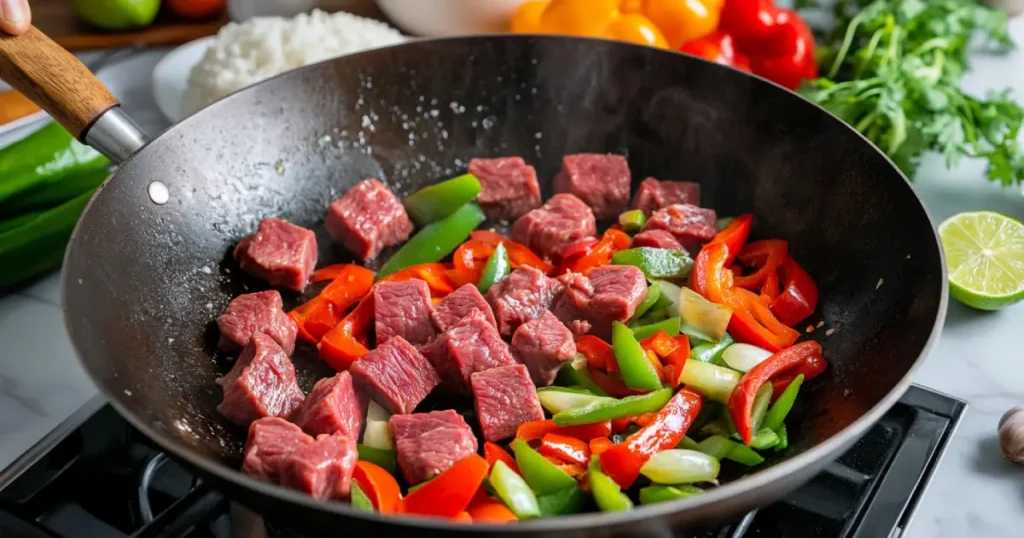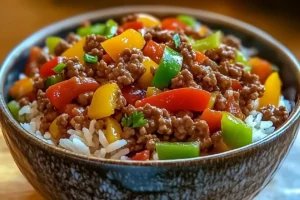Vietnamese Shaking Beef, or Bò Lúc Lắc, is a tantalizing stir-fry dish that perfectly balances tender beef, savory marinades, and vibrant accompaniments. This culinary gem is deeply rooted in Vietnamese cuisine, yet it boasts a universal appeal thanks to its simple preparation and irresistible flavors. From its cultural origins to cooking tips, this article dives deep into everything you need to know to master Vietnamese Shaking Beef. Let’s get shaking!
Outline
Introduction to Vietnamese Shaking Beef
What is Vietnamese Shaking Beef?
Vietnamese Shaking Beef, or Bò Lúc Lắc, is a flavorful stir-fry dish that brings together tender cubes of marinated beef, caramelized onions, and a zesty sauce. The name “shaking beef” stems from the vigorous shaking or tossing motion used to stir-fry the beef in a hot wok. This dish isn’t just about satisfying hunger—it’s a sensory experience of sizzling sounds, aromatic spices, and bold tastes.
Though it’s often found in Vietnamese restaurants worldwide, this dish is surprisingly easy to recreate at home. The key lies in its marinade, a harmonious blend of soy sauce, oyster sauce, garlic, and sugar that seeps into the beef, enhancing its natural juiciness. Served over a bed of watercress salad or alongside steamed rice, Vietnamese Shaking Beef is a perfect balance of comfort and sophistication.
Historical and Cultural Context of Bò Lúc Lắc
The roots of Bò Lúc Lắc trace back to Vietnam’s colonial past, influenced by French cuisine. The use of beef, once considered a luxury ingredient in Vietnam, reflects the fusion of local and French culinary traditions. Over time, this dish evolved into a beloved part of Vietnamese celebrations and everyday meals.
What makes Vietnamese Shaking Beef special is its ability to merge bold, Asian flavors with a touch of Western influence. It’s a dish that showcases Vietnam’s culinary adaptability and creativity, making it a crowd-pleaser for all occasions.
Ingredients and Their Role in Vietnamese Shaking Beef

1. Traditional Ingredients in Shaking Beef
- Main Ingredient: Tender cuts of beef such as sirloin, ribeye, or filet mignon. These cuts are prized for their marbling, ensuring juicy and succulent bites.
- Marinade: A flavorful blend of soy sauce, oyster sauce, sugar, and fish sauce that perfectly balances sweet and savory notes.
- Aromatics: Garlic, shallots, and onions add depth to the flavor and fill the kitchen with a mouthwatering aroma as the beef sizzles.
- Tangy Element: Lime juice or vinegar brings a burst of freshness to every bite.
2. Importance of Fresh, High-Quality Beef
- Why Quality Matters: Fresh, high-quality beef cooks faster, absorbs marinade effectively, and caramelizes beautifully during stir-frying.
- Ideal Cuts: Look for beef with a good fat-to-meat ratio for the best results.
- Pro Tip: Cut the beef into evenly sized cubes for even cooking, ensuring each piece is packed with flavor.
3. Key Sauces and Marinades
- Marinade Ingredients: A mix of soy sauce, oyster sauce, sugar, and garlic creates a rich, umami-packed coating for the beef.
- Nuoc Cham Sauce: This iconic Vietnamese dipping sauce, made with fish sauce, lime juice, and chilies, adds brightness and heat, complementing the dish.
- Flavor Profile: A harmonious combination of savory, tangy, and slightly sweet elements makes this dish unique.
How to Make Vietnamese Shaking Beef

4. Preparing the Beef
- Cutting: Select tender cuts of beef and cut into uniform cubes for even cooking.
- Marinating:
- Whisk together soy sauce, oyster sauce, sugar, garlic, and a splash of sesame oil.
- Soak the beef cubes in this mixture for at least 30 minutes or overnight for deeper flavor.
- Purpose: This step tenderizes the meat and infuses it with sweet and salty notes.
5. Stir-Frying Technique for Optimal Flavor
- Heat a wok or skillet until smoking hot.
- Add oil and toss in the marinated beef.
- Use quick, tossing motions (the “shaking”) to stir-fry for even cooking and caramelization.
- Add sliced onions and garlic for an aromatic boost.
- Maintain high heat to keep the beef tender and juicy, with a slight char on the outside.
6. Balancing Flavors
- While cooking, taste and adjust the seasoning:
- Add sugar if too salty.
- Squeeze lime juice for brightness.
- Aim for a perfect balance of sweet, salty, sour, and umami flavors.
7. Serving Suggestions
- Serve immediately over a bed of watercress salad or with steamed rice to soak up the savory juices.
- Enjoy a restaurant-quality Vietnamese Shaking Beef dish right at home!
Serving Suggestions and Accompaniments
Traditional Pairings: Watercress Salad and Pickled Onions
Vietnamese Shaking Beef isn’t just about the beef—it’s also about the vibrant sides that complete the dish. Traditionally, this dish is served over a bed of crisp watercress salad, which provides a refreshing contrast to the savory, caramelized beef. The peppery crunch of the watercress, combined with a simple vinaigrette of lime juice, sugar, and fish sauce, balances the richness of the beef perfectly.
Pickled onions are another classic pairing. Their tangy bite adds a burst of acidity, cutting through the meaty flavors and providing a delightful textural contrast. These accompaniments highlight the Vietnamese philosophy of balancing flavors and textures in every dish.
Modern Twists on Serving Vietnamese Shaking Beef
While the traditional accompaniments are delightful, modern adaptations of Vietnamese Shaking Beef often showcase creativity. Some chefs pair it with buttery mashed potatoes, blending East and West influences beautifully. Others serve the dish with roasted vegetables or atop a bed of quinoa for a healthy twist.
For those who enjoy a bit of spice, serving the beef with chili-infused dipping sauce or a sprinkle of crushed red pepper flakes can add an extra kick.
Nutritional Value and Health Benefits
Nutritional Breakdown of Bò Lúc Lắc
Vietnamese Shaking Beef is a well-rounded dish that offers both taste and nutritional benefits. High-quality beef is a great source of protein, essential for muscle building and repair. Depending on the cut, it can also provide important vitamins and minerals like iron, zinc, and B vitamins, which support energy production and overall health.
The dish is further enriched by its fresh accompaniments. Watercress is packed with antioxidants, vitamin C, and fiber, making it a powerhouse of nutrition. When combined with the lean protein from the beef, this meal is not only satisfying but also nourishing.
How It Fits Into a Balanced Diet
One of the best things about Vietnamese Shaking Beef is its versatility. By adjusting portion sizes or swapping out certain ingredients, it can fit into a variety of dietary preferences. Opt for lean cuts of beef to reduce fat content, or pair it with brown rice or quinoa for added fiber.
The dish’s vibrant flavor profile also means you can use less salt without sacrificing taste, making it a heart-healthy option. Whether you’re indulging in it as a treat or incorporating it into a balanced weekly meal plan, Vietnamese Shaking Beef delivers on both flavor and nutrition.
Tips for Perfecting Shaking Beef at Home
Common Mistakes to Avoid
Cooking Vietnamese Shaking Beef may seem straightforward, but a few common mistakes can impact the final dish. Overcrowding the pan is one of the biggest pitfalls.
Another mistake is not preheating the wok or skillet. A hot pan is crucial for creating the quick sear that locks in the beef’s juices. Similarly, under-marinating the beef can result in bland flavors. Make sure to let the beef soak in the marinade for at least 30 minutes, or even overnight for the best results.
Lastly, don’t forget to taste and adjust the seasoning throughout the cooking process. Balancing flavors is key to capturing the essence of Vietnamese Shaking Beef.
Pro Tips for Consistency and Authenticity
For tender, flavorful beef, choose cuts like ribeye or tenderloin, which cook quickly and absorb marinades well. Slice the beef into even cubes to ensure consistent cooking.
When stir-frying, use high heat and keep the beef moving—this prevents burning and ensures an even char. A heavy-bottomed pan or wok works best for maintaining heat.
For added authenticity, pair the dish with a classic watercress salad or pickled onions. The contrast between the savory beef and the fresh, tangy sides enhances the dining experience. With these tips, you’ll create a dish that rivals restaurant-quality Vietnamese Shaking Beef!
Experience the bold flavors of this classic Shaking Beef Recipe with easy steps from Buttery Recipes!
FAQs
Why is it called Vietnamese Shaking Beef?
The name “shaking beef” comes from the cooking technique. During preparation, the beef is constantly shaken or tossed in a hot wok or skillet to ensure even cooking and caramelization. This quick, vigorous motion creates the signature seared texture and locks in the savory marinade flavors. The sizzling sound and shaking motion make the dish as much about the cooking experience as the final result.
Is Vietnamese Shaking Beef Healthy?
Yes, Vietnamese Shaking Beef can be a healthy meal, especially when paired with fresh accompaniments like watercress salad. The dish is rich in protein and essential nutrients from the beef, while the vegetables provide vitamins and antioxidants. For a lighter version, you can use leaner cuts of beef, reduce added sugar in the marinade, and opt for low-sodium soy sauce. Balancing portion sizes and pairing it with wholesome sides like brown rice or quinoa also enhances its nutritional value.
What is the Real Name for Shaking Beef?
The authentic Vietnamese name for shaking beef is Bò Lúc Lắc. In Vietnamese, Bò means “beef,” while Lúc Lắc refers to the shaking or tossing motion used to stir-fry the beef, highlighting the dish’s unique cooking method.
What Does Lúc Lắc Mean in Vietnamese?
In Vietnamese, Lúc Lắc translates to “shaking” or “tossing.” It describes the movement of the beef in the wok or skillet as it is quickly stirred and tossed during cooking. This motion ensures even searing and gives the dish its distinct texture and flavor.
In Closing
Celebrating the Simplicity and Elegance of Vietnamese Shaking Beef
Vietnamese Shaking Beef is more than just a dish; it’s a celebration of bold flavors, tender textures, and culinary traditions. Whether you’re enjoying it at a bustling Vietnamese restaurant or preparing it at home, this dish offers an unforgettable dining experience.
The harmony of savory beef, tangy accompaniments, and a touch of sweetness makes it a favorite for all occasions. With its rich history, straightforward preparation, and endless adaptability, Vietnamese Shaking Beef remains a timeless classic. So grab your wok, shake up the beef, and savor every flavorful bite of this beloved dish!




3 thoughts on “Vietnamese Shaking Beef Authentic Cooking Tips”